
- •Preface
- •Introduction
- •Lesson Objectives
- •Lesson Agenda
- •Course Objectives
- •Course Agenda
- •Appendixes Used in the Course
- •Lesson Agenda
- •Oracle Database 11g: Focus Areas
- •Oracle Database 11g
- •Oracle Fusion Middleware
- •Oracle Enterprise Manager Grid Control 10g
- •Oracle BI Publisher
- •Lesson Agenda
- •Relational and Object Relational Database Management Systems
- •Data Storage on Different Media
- •Relational Database Concept
- •Definition of a Relational Database
- •Data Models
- •Entity Relationship Model
- •Relating Multiple Tables
- •Relational Database Terminology
- •Lesson Agenda
- •Using SQL to Query Your Database
- •SQL Statements
- •Development Environments for SQL
- •Lesson Agenda
- •The Human Resources (HR) Schema
- •Tables Used in the Course
- •Lesson Agenda
- •Oracle Database 11g Documentation
- •Additional Resources
- •Summary
- •Practice I: Overview
- •Objectives
- •Lesson Agenda
- •Capabilities of SQL SELECT Statements
- •Basic SELECT Statement
- •Selecting All Columns
- •Selecting Specific Columns
- •Writing SQL Statements
- •Column Heading Defaults
- •Lesson Agenda
- •Arithmetic Expressions
- •Using Arithmetic Operators
- •Operator Precedence
- •Defining a Null Value
- •Null Values in Arithmetic Expressions
- •Lesson Agenda
- •Defining a Column Alias
- •Using Column Aliases
- •Lesson Agenda
- •Concatenation Operator
- •Literal Character Strings
- •Using Literal Character Strings
- •Alternative Quote (q) Operator
- •Duplicate Rows
- •Lesson Agenda
- •Displaying the Table Structure
- •Using the DESCRIBE Command
- •Quiz
- •Summary
- •Practice 1: Overview
- •Objectives
- •Lesson Agenda
- •Limiting Rows Using a Selection
- •Limiting the Rows That Are Selected
- •Using the WHERE Clause
- •Character Strings and Dates
- •Comparison Operators
- •Using Comparison Operators
- •Range Conditions Using the BETWEEN Operator
- •Membership Condition Using the IN Operator
- •Pattern Matching Using the LIKE Operator
- •Combining Wildcard Characters
- •Using the NULL Conditions
- •Defining Conditions Using the Logical Operators
- •Using the AND Operator
- •Using the OR Operator
- •Using the NOT Operator
- •Lesson Agenda
- •Rules of Precedence
- •Lesson Agenda
- •Using the ORDER BY Clause
- •Sorting
- •Lesson Agenda
- •Substitution Variables
- •Using the Single-Ampersand Substitution Variable
- •Character and Date Values with Substitution Variables
- •Specifying Column Names, Expressions, and Text
- •Using the Double-Ampersand Substitution Variable
- •Lesson Agenda
- •Using the DEFINE Command
- •Using the VERIFY Command
- •Quiz
- •Summary
- •Practice 2: Overview
- •Objectives
- •Lesson Agenda
- •SQL Functions
- •Two Types of SQL Functions
- •Single-Row Functions
- •Lesson Agenda
- •Character Functions
- •Case-Conversion Functions
- •Using Case-Conversion Functions
- •Character-Manipulation Functions
- •Using the Character-Manipulation Functions
- •Lesson Agenda
- •Number Functions
- •Using the ROUND Function
- •Using the TRUNC Function
- •Using the MOD Function
- •Lesson Agenda
- •Working with Dates
- •RR Date Format
- •Using the SYSDATE Function
- •Arithmetic with Dates
- •Using Arithmetic Operators with Dates
- •Lesson Agenda
- •Date-Manipulation Functions
- •Using Date Functions
- •Using ROUND and TRUNC Functions with Dates
- •Quiz
- •Summary
- •Practice 3: Overview
- •Objectives
- •Lesson Agenda
- •Conversion Functions
- •Implicit Data Type Conversion
- •Explicit Data Type Conversion
- •Lesson Agenda
- •Using the TO_CHAR Function with Dates
- •Elements of the Date Format Model
- •Using the TO_CHAR Function with Dates
- •Using the TO_CHAR Function with Numbers
- •Using the TO_NUMBER and TO_DATE Functions
- •Using the TO_CHAR and TO_DATE Function with RR Date Format
- •Lesson Agenda
- •Nesting Functions
- •Lesson Agenda
- •General Functions
- •NVL Function
- •Using the NVL Function
- •Using the NVL2 Function
- •Using the NULLIF Function
- •Using the COALESCE Function
- •Lesson Agenda
- •Conditional Expressions
- •CASE Expression
- •Using the CASE Expression
- •DECODE Function
- •Using the DECODE Function
- •Quiz
- •Summary
- •Practice 4: Overview
- •Objectives
- •Lesson Agenda
- •What Are Group Functions?
- •Types of Group Functions
- •Group Functions: Syntax
- •Using the AVG and SUM Functions
- •Using the MIN and MAX Functions
- •Using the COUNT Function
- •Using the DISTINCT Keyword
- •Group Functions and Null Values
- •Lesson Agenda
- •Creating Groups of Data
- •Creating Groups of Data: GROUP BY Clause Syntax
- •Using the GROUP BY Clause
- •Grouping by More than One Column
- •Using the GROUP BY Clause on Multiple Columns
- •Illegal Queries Using Group Functions
- •Restricting Group Results
- •Restricting Group Results with the HAVING Clause
- •Using the HAVING Clause
- •Lesson Agenda
- •Nesting Group Functions
- •Quiz
- •Summary
- •Practice 5: Overview
- •Objectives
- •Lesson Agenda
- •Types of Joins
- •Joining Tables Using SQL:1999 Syntax
- •Qualifying Ambiguous Column Names
- •Lesson Agenda
- •Creating Natural Joins
- •Retrieving Records with Natural Joins
- •Creating Joins with the USING Clause
- •Joining Column Names
- •Retrieving Records with the USING Clause
- •Using Table Aliases with the USING Clause
- •Creating Joins with the ON Clause
- •Retrieving Records with the ON Clause
- •Creating Three-Way Joins with the ON Clause
- •Applying Additional Conditions to a Join
- •Lesson Agenda
- •Joining a Table to Itself
- •Self-Joins Using the ON Clause
- •Lesson Agenda
- •Nonequijoins
- •Retrieving Records with Nonequijoins
- •Lesson Agenda
- •INNER Versus OUTER Joins
- •LEFT OUTER JOIN
- •RIGHT OUTER JOIN
- •FULL OUTER JOIN
- •Lesson Agenda
- •Cartesian Products
- •Generating a Cartesian Product
- •Creating Cross Joins
- •Quiz
- •Summary
- •Practice 6: Overview
- •Objectives
- •Lesson Agenda
- •Using a Subquery to Solve a Problem
- •Subquery Syntax
- •Using a Subquery
- •Guidelines for Using Subqueries
- •Types of Subqueries
- •Lesson Agenda
- •Single-Row Subqueries
- •Executing Single-Row Subqueries
- •Using Group Functions in a Subquery
- •The HAVING Clause with Subqueries
- •What Is Wrong with This Statement?
- •No Rows Returned by the Inner Query
- •Lesson Agenda
- •Multiple-Row Subqueries
- •Lesson Agenda
- •Null Values in a Subquery
- •Quiz
- •Summary
- •Practice 7: Overview
- •Objectives
- •Lesson Agenda
- •Set Operators
- •Set Operator Guidelines
- •The Oracle Server and Set Operators
- •Lesson Agenda
- •Tables Used in This Lesson
- •Lesson Agenda
- •UNION Operator
- •Using the UNION Operator
- •UNION ALL Operator
- •Using the UNION ALL Operator
- •Lesson Agenda
- •INTERSECT Operator
- •Using the INTERSECT Operator
- •Lesson Agenda
- •MINUS Operator
- •Using the MINUS Operator
- •Lesson Agenda
- •Matching the SELECT Statements
- •Matching the SELECT Statement: Example
- •Lesson Agenda
- •Using the ORDER BY Clause in Set Operations
- •Quiz
- •Summary
- •Practice 8: Overview
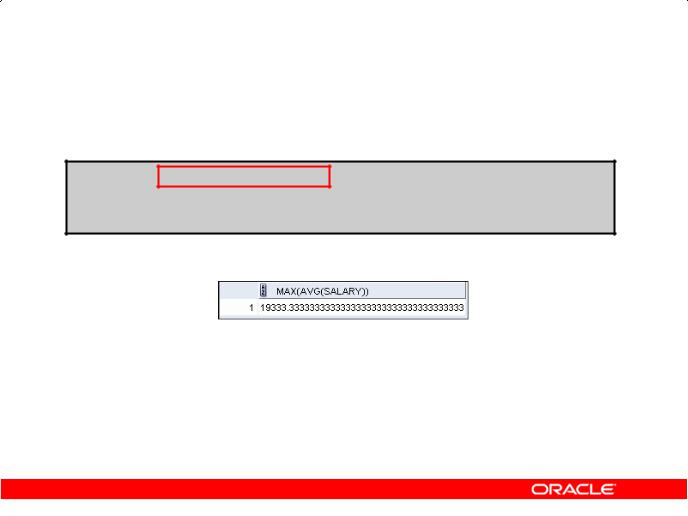
Nesting Group Functions
Display the maximum average salary:
SELECT MAX(AVG(salary))
FROM employees
GROUP BY department_id;
Nesting Group Functions |
Copyright © 2009, Oracle. All rights reserved. |
Academy |
|||
|
|
|
|||
|
|
|
Oracle |
||
|
Group functions can be nested to a depth of two functions. The xample in the slide calculates the |
||||
|
average salary for each department_id and then displays the maximum average salary. |
||||
|
Note that GROUP BY clause is mandatory when nesting g oup functions. |
||||
|
|
& |
Only |
|
|
|
Internal |
|
|
|
|
Oracle |
Use |
|
|||
|
|
|
|
||
Oracle Database 11g: SQL Fundamentals I 5 - 26

Quiz
Identify the guidelines for group functions and the GROUP BY clause.
1. You cannot use a column alias in the GROUP BY clause. 2. The GROUP BY column must be in the SELECT clause.
3. By using a WHERE clause, you can exclude rows before dividing them into groups.
4. The GROUP BY clause groups rows and ensures order of the result set.
5.If you include a group function in a SELECT clause, you cannot select individual results as well.
Answer: 1, 3 |
Copyright © 2009, Oracle. All rights reserved. |
Academy |
|||
|
|
|
|||
|
|
|
Oracle |
||
|
|
& |
Only |
|
|
|
Internal |
|
|
|
|
Oracle |
Use |
|
|||
|
|
|
|
||
Oracle Database 11g: SQL Fundamentals I 5 - 27
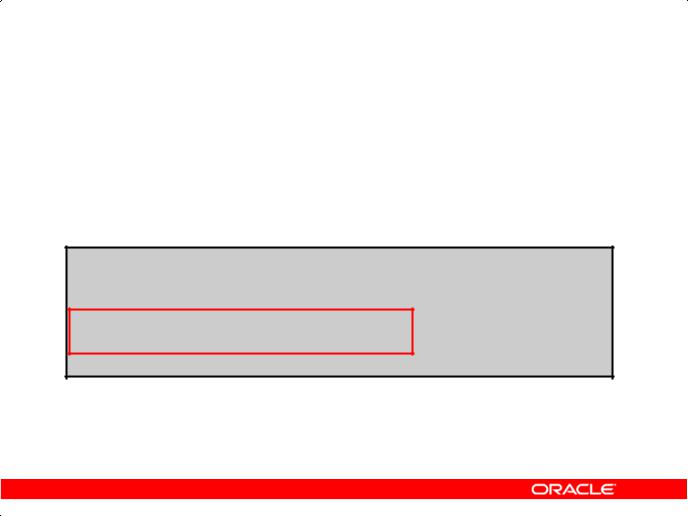
Summary
In this lesson, you should have learned how to:
•Use the group functions COUNT, MAX, MIN, SUM, and AVG
•Write queries that use the GROUP BY clause
•Write queries that use the HAVING clause
SELECT column, group_function FROM table
[WHERE condition]
[GROUP BY group_by_expression] [HAVING group_condition]
[ORDER BY column];
Copyright © 2009, Oracle. All rights reserved. |
Academy |
Summary |
|
There are several group functions available in SQL, such as: |
|
AVG, COUNT, MAX, MIN, SUM, STDDEV, and VARIANCE |
|
Oracle |
|
You can create subgroups by using the GROUP BY clause. Further, groups can be restricted using the
HAVING clause.
Place the HAVING and GROUP BY clauses after the WHERE c ause in a statement. The order of the |
||
GROUP BY and HAVING clauses following&the WHERE clause is not important. Place the ORDER BY |
||
clause at the end. |
Only |
|
The Oracle server evaluates the clauses in the following order: |
||
1. |
If the statement con ains a WHERE clau e, the server establishes the candidate rows. |
|
2. |
The server identifies |
he groups thatUseare specified in the GROUP BY clause. |
3. |
The HAVING Internalclause further restricts result groups that do not meet the group criteria in the |
|
|
HAVING c ause. |
|
Oracle |
|
|
Note: For a omplete list of the group functions, see Oracle Database SQL Language Reference 11g, Rele se 1 (11.1).
Oracle Database 11g: SQL Fundamentals I 5 - 28

Practice 5: Overview
This practice covers the following topics:
•Writing queries that use the group functions
•Grouping by rows to achieve more than one result
•Restricting groups by using the HAVING clause
Practice 5: Overview |
Copyright © 2009, Oracle. All rights reserved. |
Academy |
|||
|
|
|
|||
|
|
|
Oracle |
||
|
At the end of this practice, you should be familiar with using group functions and selecting groups of |
||||
|
data. |
|
|
Only |
|
|
|
& |
|
||
|
Internal |
|
|
|
|
Oracle |
Use |
|
|||
|
|
|
|
||
Oracle Database 11g: SQL Fundamentals I 5 - 29
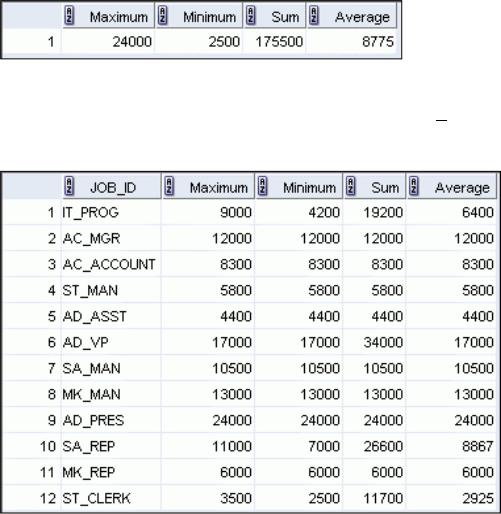
Practice 5
Determine the validity of the following three statements. Circle either True or False.
1.Group functions work across many rows to produce one result per group. True/False
2.Group functions include nulls in calculations.
True/False
3.The WHERE clause restricts rows before inclusion in a group calculation. True/False
The HR department needs the following reports:
4. Find the highest, lowest, sum, and average salary of all employees. Label the columns
as Maximum, Minimum, Sum, and Average, respectively. Round your results to the nearest whole number. Save your SQL statement as lab_05_04.sql. Run the query.
|
|
Academy |
5. Modify the query in lab_05_04.sql to display the minimum, maximum, sum, and average |
||
salary for each job type. Resave lab_05_04.sql as lab_05 05.sql. Run the statement |
||
in lab_05_05.sql. |
|
|
|
Oracle |
|
|
& |
Only |
Internal |
|
|
|
Use |
|
Oracle |
|
|
Oracle Database 11g: SQL Fundamentals I 5 - 30
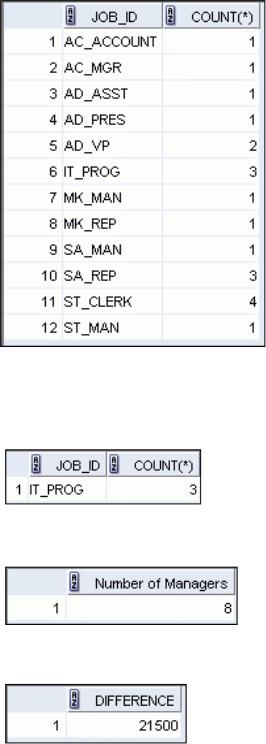
Practice 5 (continued)
6. Write a query to display the number of people with the same job.
|
|
Academy |
Generalize the query so that the user in the HR department is prompted for a job title. Save the script |
||
to a file named lab_05_06.sql. Run the query. Enter IT_PROG when prompted. |
||
|
Oracle |
|
7. Determine the number of managers without listing them. Lab l the column as Number of |
||
Managers. Hint: Use the MANAGER_ID column to determine the number of managers. |
||
& |
Only |
|
Internal |
|
|
8. Find the difference between the highest and lowest salaries. Label the column DIFFERENCE. |
||
Use |
||
Oracle |
|
|
Oracle Database 11g: SQL Fundamentals I 5 - 31
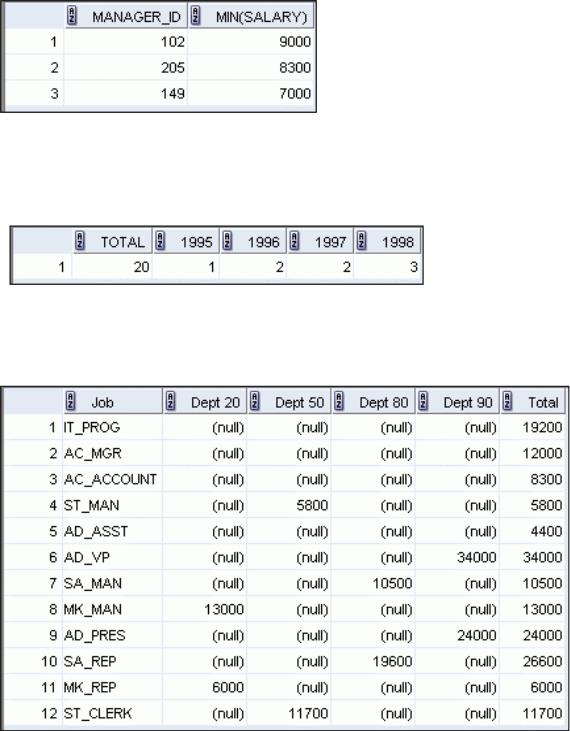
Practice 5 (continued)
If you have time, complete the following exercises:
9.Create a report to display the manager number and the salary of the lowest-paid employee for that manager. Exclude anyone whose manager is not known. Exclude any groups where the minimum salary is $6,000 or less. Sort the output in descending order of salary.
If you want an extra challenge, complete the following exercises:
10. Create a query to display the total number of employees and, of that total, the number of employees hired in 1995, 1996, 1997, and 1998. Create appropriate column headings.
|
|
Academy |
11. Create a matrix query to display the job, the salary for that job based on department number, |
||
and the total salary for that job, for departments 20, 50, 80, and 90, giving each colu n an |
||
appropriate heading. |
|
|
|
Oracle |
|
|
& |
Only |
Internal |
|
|
|
Use |
|
Oracle |
|
|
Oracle Database 11g: SQL Fundamentals I 5 - 32

Displaying Data from Multiple Tables
|
Copyright © 2009, Oracle. All rights reserved. |
Academy |
||
|
|
|||
|
|
Oracle |
||
& |
Only |
|
||
|
Internal |
|
|
|
|
Use |
|
||
Oracle |
|
|
|
|
